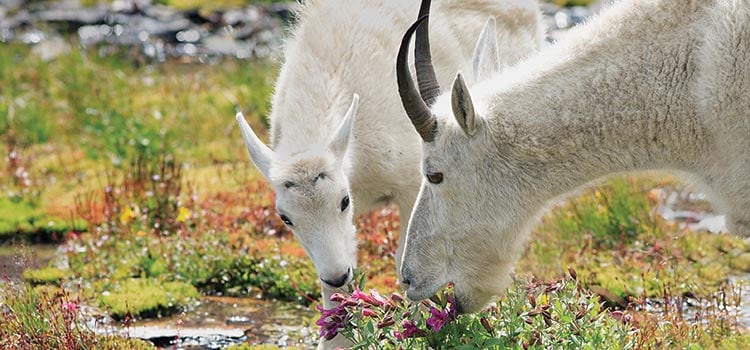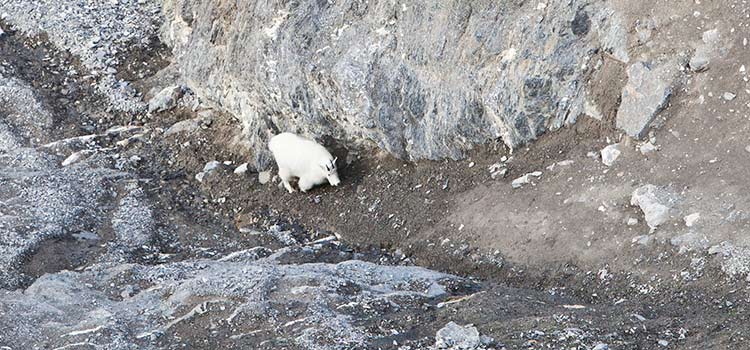There are so many captivating species of wildlife roaming freely in the pristine wilderness of Jasper National Park. Mountain goats cling to the steep cliffs of the Rocky Mountains. They're incredible to spot in person!
As an attractions and hospitality, we welcome guests from around the world to experience the best of the Canadian Rockies. Park conservation plays an important role in our operation, and we endeavour to be stewards of the land. Prior to building the Columbia Icefield Skywalk we commissioned a comprehensive third party environmental study to determine what impact its construction might have on the area’s mountain goat and bighorn sheep population.
Matt Laitinen, our Manager of Programming and Experience at the Columbia Icefield, assisted with the audit’s data collection and is now sharing key findings from the report.

Why did Pursuit commission the study?
We commissioned the study to gain a better understanding of the potential impact that the Skywalk may pose on the current population and movement patterns of local mountain goats and bighorn sheep. In addition to the Mountain Goat Project, Parks Canada conducted a secondary environmental assessment to ensure that every aspect of Jasper National Park’s ecosystem was considered, and that potential negative impacts were mitigated.
Who completed the study?
Pursuit engaged Calgary-based engineering firm Golder Associates to conduct the study. Talus Technologies was subcontracted to install wildlife cameras and collect the data.

When was the study conducted?
We began the Mountain Goat Project in 2011, a year prior to breaking ground on the Skywalk. Each year, between May and October, data was collected and an annual report outlining the findings was produced. The study was conducted over an eight-year period and finished in 2019.
How was the study conducted?
Talus Technologies installed a series of wildlife video cameras in the Sunwapta Canyon, as well as the area directly above the Skywalk construction site. A representative from Talus trained members of the Pursuit team on how to locate the GPS marked cameras and collect the memory cards. Every six weeks we exchanged the memory cards and couriered the data directly to Talus in Calgary. Talus monitored the animals’ movement along cliff faces and local trails, as well as counted how many animals frequented the area. Trends were identified, and the data was then compiled into an annual report with the findings. Parks Canada also monitored the movement and count of mountain goats and bighorn sheep using its own dedicated cameras.
What are the results from the study?
The study found that the mountain goats and bighorn sheep were not overly affected by Skywalk construction, nor by its May through October operation thereafter. In fact, some years—like 2017 for example—realized more activity than prior to construction starting.

Do you know why these animals frequent this area specifically?
We understand, from the reports, that mountain goats and bighorn sheep use the area to safely avoid predators. The landscape is primarily comprised of steep and rugged cliffs, which make for difficult hunting grounds. June is the kidding season, and Skywalk operates reduced hours during this time to limit any potential noise and activity that could cause stress to females and their offspring. Construction was also scaled back during this time. We are still monitoring wildlife activity internally using the existing cameras, and it’s always exciting to see newborn kids in the early summer months.
Can you share any other key learnings?
The animals in the area, like their parents before them, have been exposed to tourism for decades—long before the opening of Skywalk. As such, wildlife in this area have interacted with humans on a regular basis. Unfortunately, sometimes in tourism we see irresponsible acts, such as the feeding of wildlife—which should never happen. The Skywalk’s location, which was previously a scenic rest stop, makes it more difficult for people to closely interact with wildlife, and it’s helping to create more responsible viewing practices. We also noted that common road construction, and rock-scaling, will push wildlife out of the area, but only temporarily. Once construction stops, the animals return.
What's important for the public to know?
Prior to the Skywalk, thousands of vehicles used the scenic rest stop every year. Sadly, this resulted in excess garbage, much of which would find its way into the Sunwapta Valley. Now that we are responsible for the area, we manage a valley clean-up project, and our team ensures that waste is properly disposed or recycled. We’ve also built a barrier between the wildlife, and the public. There are several other areas in Jasper National Park where mountain goats and bighorn sheep can be sighted. It’s important that if you do see wildlife that you don’t approach or try to feed them, for both the safety of yourself and the animals that live here.
For more information, please visit our Responsible Wildlife Viewing Tips.
We are building a team of passionate people determined to make a difference in the places we love. Every effort counts. Meet more of them here and discover how Promise to Place is the real deal.
Learn More
Insider tips, inspiration and deals — delivered straight to your inbox.